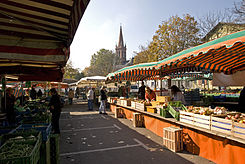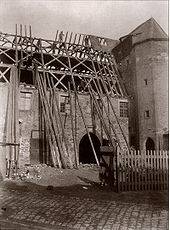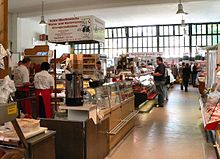Highest market
| Highest market | |
|---|---|
| Place in Frankfurt am Main | |
 In October 2008 |
|
| Basic data | |
| place | Frankfurt am Main |
| District | Maximum |
| Created | 20th century |
| Confluent streets | Melchiorstraße (north), Justinuskirchstraße (east), Antoniterstraße (west) |
| Buildings | Markthalle Höchst, synagogue (†), Brüningbrunnen , part of the city wall |
The Höchst Market is a 1,700 m² square on the northern edge of the old town of Frankfurt-Höchst , between Melchior-, Antoniter- and Justinuskirchstraße. Every Tuesday, Friday and Saturday morning the traditional Höchst weekly market takes place there and in the adjoining market hall, which attracts numerous customers from the west of Frankfurt and the neighboring communities of the Main-Taunus district . Outside the market days, the area serves as a parking lot.
The seat
Between 1920 and 1923 the highest city council discussed a new location for the weekly market. At that time it was held in front of the Antoniterkloster in Hauptstrasse, today's Bolongarostrasse . The location was no longer tenable, as the volume of traffic in the narrow main road, part of the main road to Mainz, was steadily increasing. The city administration therefore decided in 1923 to create a new market square in the north of the old town in the area of the “Horstmannschen Garten”, which belonged to the Höchst City Garden. The Höchst Beautification Association had this green area built in place of the old city moat at the end of the 19th century. The first weekly market at the new location took place in November 1923.
Development
The new Höchst synagogue was inaugurated on the eastern edge of the square in 1905 . The building was destroyed during the November pogroms in 1938 and an air raid shelter was built in its place. A plaque on the west facade of the bunker reminds of the synagogue today. In front of the bunker was the “ War ” memorial , a bronze sculpture by the Höchst artist Richard Biringer (1877–1947). The sculpture from 1928 was destroyed during the Nazi era and re-cast in 1982.
The houses on the southern edge of the square date from the late Wilhelminian era. The northern city wall originally ran here, a piece of which is still preserved on the southwest side of the square at the confluence of the “Rosengasse” - part of Antoniterstraße. In 1893 the 14th century Zehnthof, today the Höchst Market 3 building, was demolished. Only the Gothic stair tower remained and was integrated into the rear of the new house. In 1927 the former porcelain yard between Wed Gasse and Rosengasse was demolished. The Höchst Porcelain Manufactory was based here from 1746 to 1796. The houses on the north side of the square, which have a mixed structure of apartments and small businesses, also date from the time before the First World War.
The Brüningbrunnen is located on the northeast corner of the Höchst market . It was originally built in 1910 in memory of Adolf von Brüning , the co-founder of Hoechst AG , and his wife Clara on the Höchst Castle Square , but was moved to the market square in the summer of 1938.
More recent plans to completely redesign the Hoechster Markt by building an underground car park and a new hall that would have covered almost the entire area of the square have not been pursued since 2006. On the one hand, the necessary funds are lacking, and on the other hand, these plans, which could have led to the destruction of the Höchst Weekly Market during the construction period due to a lack of alternative space, met with broad criticism from the population, regular customers of the market and the stand operators. The latter feared, in addition to the construction-related suspension of the market for a long time, significantly higher stand fees in the planned new hall.
Market hall
The radical plan of the Höchst city architect Carl Rohleder from 1924 envisaged tearing down the entire northern old town between Storchgasse and Wed in order to make space for a new market square and a market hall. However, the plan could not be realized because the city of Höchst lacked the means to purchase the land due to inflation , the costs of the French occupation between 1918 and 1930 and dwindling trade tax income.
In the incorporation agreement of March 1928, the city of Höchst agreed with Frankfurt to build a market hall within five years. However, the consequences of the global economic crisis and the political goals of the National Socialist rulers after 1933, to which the almost autonomous position of the Höchst district with its own budget agreed in the contract did not fit, prevented the construction project from being realized.
After the Second World War, the Höchst returned to the details of the incorporation agreement and demanded that the city of Frankfurt fulfill the commitments under threat of incorporation. On the initiative of the mayor at the time, Walter Kolb , who lived in Höchst and thus directly experienced the Hochst's displeasure with Frankfurt, the indoor swimming pool and tram connection as well as the market hall were built. It was opened on November 15, 1955. In 2006, for the 650th anniversary of the Höchst market, the dilapidated sanitary facilities in front of the hall were renovated.
The highest weekly market
The creation of the Höchst weekly market can be dated to the exact day. On February 11, 1355, the village of Hoesten was raised to a town by Emperor Charles IV . Almost a year later, on January 12, 1356, Charles confirmed the town's elevation in another document and at the same time granted the young town market rights . The document text is in today's notation:
- Also in the above city they are to celebrate and hold a weekly market every Tuesday, and the above city is to have all the rights and freedoms, grace and good habits and use them fully on the same market day and in all other ways and things, as ours and des The above-mentioned rich city of Franckenfurt has and has used it and has also come from ancient times.
It is no longer possible to determine exactly where the original marketplace was. The assessment varies between the Höchst Schloßplatz and the square in front of the Old Town Hall a few meters further east. With two city extensions in the 15th century, the city fortifications were extended to the east. It was originally located directly east of the Justinuskirche and Badstubengasse and now ran east of the Antoniterkloster, built in 1442, at the confluence of today's Storchgasse. In the area between Badstubengasse and Storchgasse, the main street was expanded into a square. The Höchst weekly market took place here at the latest from the 16th century until 1923.
The weekly market, as an outpost of Kurmainz against Frankfurt , gave the young city additional economic privileges, including the right to staple , and quickly made Höchst an economic sub-center of the Rhine-Main area. From the middle of the 15th century to the middle of the 19th century, market ships also regularly operated between Mainz and Frankfurt, which stopped in Höchst to reload and sell goods. The market was an important sales area for the Höchst fishermen's guild, and fishermen from the surrounding communities also had to offer their goods here before they were allowed to sell them elsewhere. Again and again, the Höchst weekly market and its favorable conditions for providers led to a dispute with its large neighbor Frankfurt. The market day, originally set to Tuesday, was extended to Friday in the 18th century, and Saturday was added later as a market day.
The fact that the Höchst city administration still attached considerable importance to the weekly market in the 20th century is shown in the incorporation negotiations with Frankfurt and the resulting contract. The construction of the market hall was agreed, as was an independent weekly market for Sindlingen and Zeilsheim . These had only been incorporated into Höchst eleven years earlier. The contract says “to further develop the market, to create a new one for Sindlingen-Zeilsheim” and further “to build a retail market hall within 5 years within the framework of the necessary requirements” .
With around 50 stalls, the Höchst market is the second largest weekly market in Frankfurt. The three market days a week are regularly well received in Höchst and the surrounding districts as well as in the neighboring communities of the former district of Höchst . This shows that even after 650 years the Höchst weekly market has lost none of its importance.
photos
- At the edge of the market square
literature
- Wilhelm Frischholz: Alt-Höchst. A home book in words and pictures. Frankfurt am Main 1926: Hauser.
- Wolfgang Metternich: The urban development of Höchst am Main. Frankfurt-Höchst 1990: City of Frankfurt and Association for History and Archeology.
- Rudolf Schäfer: Höchst am Main. Frankfurt am Main 1981: Frankfurter Sparkasse from 1822.
- Rudolf Schäfer: Chronicle of Höchst am Main. Frankfurt am Main 1986: Waldemar Kramer.
Web links
- Highest market at par.frankfurt.de , the former website of the city of Frankfurt am Main
Individual evidence
- ↑ Stadtvermessungsamt Frankfurt am Main (ed.): Portal GeoInfo Frankfurt , city map
- ↑ Institute for Urban History Frankfurt am Main ( Memento of the original from March 3, 2016 in the Internet Archive ) Info: The archive link has been inserted automatically and has not yet been checked. Please check the original and archive link according to the instructions and then remove this notice.
- ^ Wolfgang Metternich: Tuesdays, Fridays and Saturdays. 650 years of the weekly market in Höchst am Main. In: Vereinsring Frankfurt (M) -Höchst eV (ed.): Festschrift for the 2006 Höchst Castle Festival. Frankfurt am Main 2006. pp. 22–29. (PDF; 1 MB) ( Memento of the original from September 27, 2007 in the Internet Archive ) Info: The archive link was inserted automatically and has not yet been checked. Please check the original and archive link according to the instructions and then remove this notice.
- ↑ Incorporation contract between the municipality of Frankfurt and the municipality of Höchst am Main from 1928 (PDF; 88 kB), accessed on Feb. 25, 2020
- ↑ Municipal program of the city of Höchst as an annex to the incorporation agreement of 1928 (PDF; 89 kB), accessed on Feb. 25, 2020
Coordinates: 50 ° 5 ′ 59 ″ N , 8 ° 32 ′ 46 ″ E











